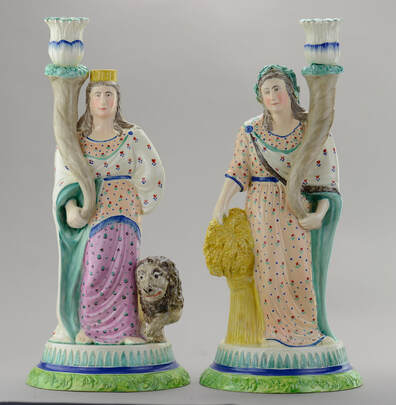The inspiration for these figures is a pair of Wedgwood blue and white jasper candlesticks. Eliza Meteyard, Wedgwood’s biographer, says of them, “Articles of this character and quality were always costly, namely £5 5sh.” That was a lot of money in those days, so Staffordshire potters took up the gauntlet and made much prettier versions, and, I would guess, at a more affordable price.
So why would Ceres and Cybele be paired? Did you know that the Romans considered both goddesses to be Earth Mothers associated with fertility? On the other hand, their devotees were divided. Rome had two hereditary classes of citizens: patricians, the elite, wealthy landowners, and plebeians (plebs), the commoners. One adopted Ceres as Magna Mater (Great Mother), and the other chose Cybele.
Ceres, based on the Greek goddesses Demeter, was first established in Southern Italy, but Rome imported her in the third century BCE. As the divine embodiment of agriculture, she quickly became the patron goddess of the plebs who were central to Roman economy. And her association with fertility also made her the guardian of marriage. Her name was synonymous with wheat, and even today she is in modern symbols linked to organizations associated with agriculture.
Cybele, originally a Phrygian earth mother, was portrayed in the ancient world wearing a turreted or mural crown (symbolizing her status as a guarding deity) and riding a chariot drawn by lions. Later, the Greeks adopted her, but shortly after Ceres arrived in Rome, patrician Romans decided they needed something more. Patricians had a fertility problem (caused by rampant lead poisoning) that was imperiling their elite blood lines, and none of the existing goddesses was helping. Believing that corn was first created in Phrygia, and associating Cybele with corn, fertility, and agricultural bounty, they established her as their very own Magna Mater. In record time, the harvest was abundant and the second Punic War was over!
Roman mythographers, knowing which side their bread was buttered, established Cybele as the ancestral goddess of the Roman people, and leading patrician families claimed to be her descendants. Her association with agricultural fertility and the protection of cities made her acceptable despite the frenzied, and sometimes-bloody activities associated with her cult, and she became a favorite for patrician women with fertility issues.
Today, the divisions in our society run deep. Republican or Democrat? Labour or Conservative? Step back over two thousand years ago, it was Ceres or Cybele, and your blood line, rather than your convictions, determined your choice.
The Girls traveled to America swaddled in layers of wrap within a very large box. Tucked in with them was yet another treasure, just 4 inches tall, at the other end of the size spectrum. About five years ago, Damon Revans-Turner visited our collection, and, when he subsequently acquired a small clown, he recalled that we have its companion, a sweet little man holding a vegetable of sorts. The two make a perfect pair, and, as the only other clown I know of is “jailed” in a museum storage room, I am thrilled to have found this one. Could you wish for a more perfect pair?




















